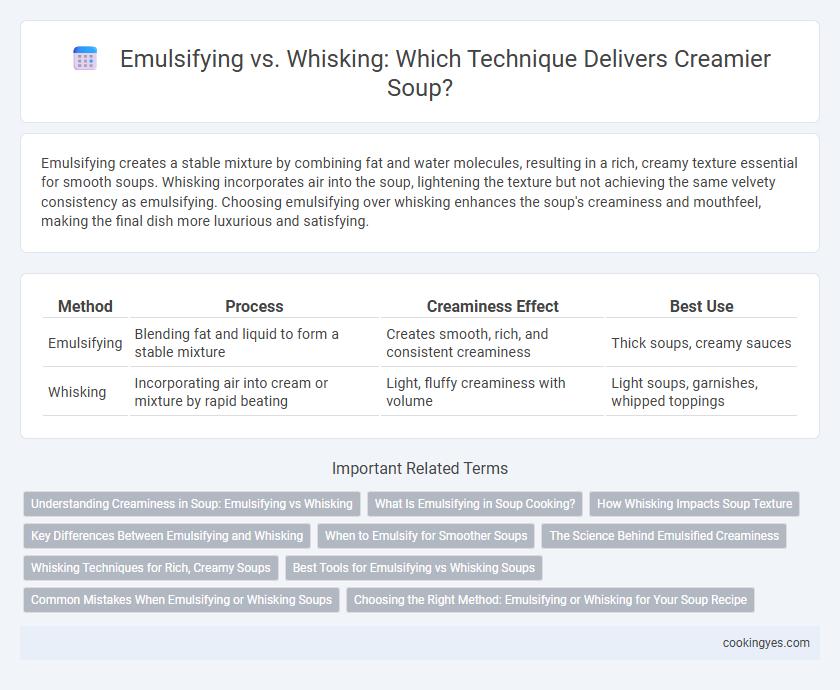Emulsifying creates a stable mixture by combining fat and water molecules, resulting in a rich, creamy texture essential for smooth soups. Whisking incorporates air into the soup, lightening the texture but not achieving the same velvety consistency as emulsifying. Choosing emulsifying over whisking enhances the soup's creaminess and mouthfeel, making the final dish more luxurious and satisfying.
Table of Comparison
| Method | Process | Creaminess Effect | Best Use |
|---|---|---|---|
| Emulsifying | Blending fat and liquid to form a stable mixture | Creates smooth, rich, and consistent creaminess | Thick soups, creamy sauces |
| Whisking | Incorporating air into cream or mixture by rapid beating | Light, fluffy creaminess with volume | Light soups, garnishes, whipped toppings |
Understanding Creaminess in Soup: Emulsifying vs Whisking
Emulsifying in soup involves blending fat and liquid to create a smooth, stable mixture that enhances creaminess by preventing separation, while whisking aerates the liquid, incorporating air that results in a lighter texture but less stable creaminess. Creamy soups like bisques rely on emulsifying to maintain consistent richness, whereas whisking is often used for frothier, less dense textures. Understanding these techniques helps achieve desired soup textures by controlling fat dispersion and air integration.
What Is Emulsifying in Soup Cooking?
Emulsifying in soup cooking refers to the process of blending two immiscible liquids, such as oil and water, into a stable mixture that enhances creaminess and texture. This technique involves slowly incorporating fat, like butter or cream, into the broth while whisking vigorously or using an immersion blender to create a smooth, velvety consistency. Emulsification improves the mouthfeel of soups such as bisques and chowders by evenly distributing fat particles, preventing separation, and intensifying flavor delivery.
How Whisking Impacts Soup Texture
Whisking rapidly incorporates air and breaks down fat droplets, creating a smoother and lighter soup texture. This mechanical action evenly distributes ingredients, preventing separation and enhancing the creamy mouthfeel without adding emulsifiers. Unlike emulsifying, which chemically binds fat and liquid, whisking relies on physical agitation to improve soup consistency and viscosity.
Key Differences Between Emulsifying and Whisking
Emulsifying in soup involves blending two immiscible liquids, such as oil and water, into a stable, creamy mixture using emulsifiers like mustard or egg yolk, resulting in a smooth texture and uniform flavor distribution. Whisking mechanically incorporates air into the mixture, increasing volume and lightness but not necessarily creating a stable blend of ingredients. The key difference lies in emulsifying producing a cohesive, stable creaminess by chemically combining ingredients, whereas whisking primarily aerates, enhancing texture without altering the fundamental mixture stability.
When to Emulsify for Smoother Soups
Emulsifying is essential for achieving a smoother, creamier soup by thoroughly blending fat and liquid components into a stable mixture, preventing separation and enhancing mouthfeel. This technique is particularly effective when incorporating oils, butter, or dairy into brothy soups to create a velvety texture without lumps. Whisking, while useful for mixing, does not create the same stable emulsion, so emulsifying should be prioritized when aiming for rich, silky soup consistency.
The Science Behind Emulsified Creaminess
Emulsifying soup involves combining fat and water molecules into a stable mixture, creating a smooth, creamy texture by dispersing tiny fat droplets throughout the liquid. Whisking, while incorporating air and blending ingredients, does not achieve the same uniform fat distribution, often leading to less stable creaminess. The science behind emulsified creaminess lies in the formation of microscopic oil droplets surrounded by emulsifiers, which prevent separation and enhance mouthfeel in soups.
Whisking Techniques for Rich, Creamy Soups
Whisking incorporates air into the soup, creating a smooth, velvety texture essential for rich, creamy soups. Employing rapid, circular wrist movements distributes fats and liquids evenly, preventing separation and enhancing mouthfeel. Consistent whisking during cooking ensures emulsification without the need for added stabilizers, yielding a naturally creamy soup.
Best Tools for Emulsifying vs Whisking Soups
Using an immersion blender provides superior emulsifying power for achieving a smooth, creamy soup by fully blending fats and liquids into a stable mixture. In contrast, a balloon whisk is ideal for gently whisking soups to incorporate air without breaking down ingredients, perfect for lighter textures and delicate emulsions. For optimal creaminess, choose an immersion blender when a velvety consistency is desired and a balloon whisk for subtle aeration and texture control.
Common Mistakes When Emulsifying or Whisking Soups
Common mistakes when emulsifying soups include adding oil too quickly, causing the mixture to break and lose its creamy texture. Whisking errors often occur from over-whisking, which can incorporate too much air and result in a frothy, less smooth consistency. Maintaining the right temperature and gradually combining ingredients ensures a stable emulsion and a silky, creamy soup.
Choosing the Right Method: Emulsifying or Whisking for Your Soup Recipe
Emulsifying combines fat and liquid phases into a smooth, stable mixture essential for creamy soups like bisques, enhancing texture and mouthfeel. Whisking incorporates air and evenly blends ingredients, ideal for lighter, frothy soups or those finished with dairy to create a velvety consistency. Selecting emulsifying or whisking depends on desired soup richness and texture, with emulsifying suited for thick, luxurious bases and whisking perfect for airy, delicate finishes.
Emulsifying vs Whisking for Creaminess Infographic

 cookingyes.com
cookingyes.com